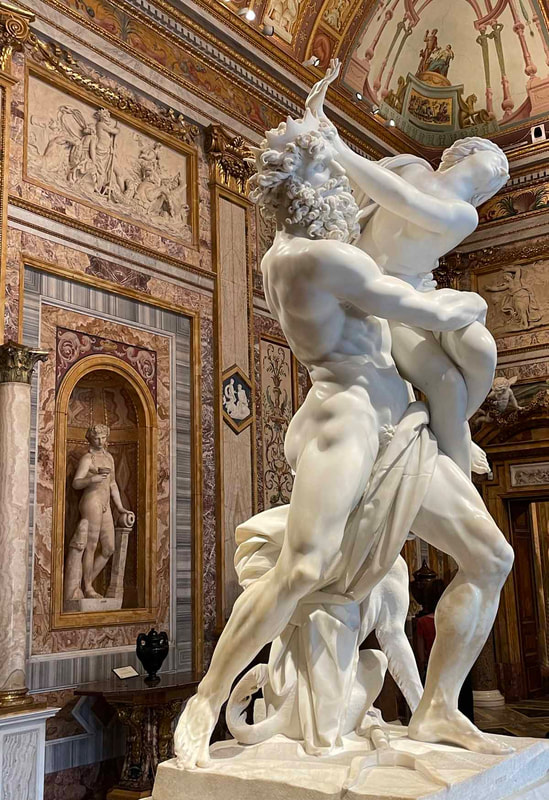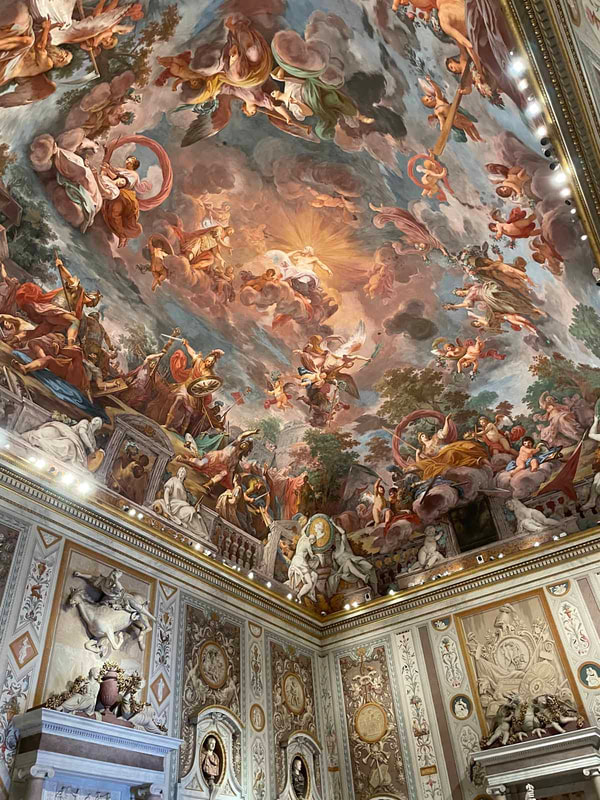|
The Borghese Gallery (Galleria Borghese) in Rome is one of the world's great art museums. Small in size, it contains numerous masterpieces of Ancient, Renaissance, Baroque and Neo-classical art. These are displayed in galleries whose decoration enhances both the presentation of these masterpieces and the overall experience of visiting the museum.
The Borghese family accumulated a fortune as bankers in the Italian city of Siena. They shifted their base of operation to Rome in the late 15th century where they continued to be powerful and influential. In 1605, Camillo Borghese was elected Pope and took on the name Paul V. Determining that he would need a place for getting away from things and entertaining, the new Pope decided to build a villa on Borghese property on the other side of the Tiber from the Vatican just outside the city walls of Rome. Work was begun on the new villa in 1607. It became known as the Villa Borghese Pinciana, reflecting the section of Rome that it was in. The Pope wanted his villa to be impressive. Therefore, he gave his nephew Cardinal Scipione Borghese the task of creating the villa. Cardinal Scipione did not fail at his task. Architect Flaminio Ponzip was hired to develop sketches the Cardinal drew of the new villa. The Cardinal – using whatever means available to him - also assembled a world-class art collection that included ancient Roman statues and mosaics, existing Renaissance masterpieces and newly-commissioned Baroque works. In addition, the walls, ceilings and floors were lavishly decorated. Visitors could not help but be impressed. Considering that the man in charge of this project was a Cardinal, one might expect the villa to be somber and the collection devoted to religious subjects. However, the villa is bright, ornate and luxurious. Furthermore, the art work devoted to nude pagan gods and goddesses outnumbers those works with Biblical subjects. The villa remained in the Borghese family until 1902. During that time, there were both additions and subtractions from the collection. For example, in 1808, Prince Camillo Borghese was persuaded to sell some of the collection's ancient Roman statues to his brother-in-law Napoleon I. At the same time, however, the collection was augmented by Antonio Canova's masterpiece statue of the Prince's wife, Pauline Bonaparte, as the naked Venus. Today. the collection is displayed on two floors of the villa encompassing some 20 rooms. One floor is devoted primarily to sculpture while the other is devoted primarily to painting. Dominating the sculpture collection is a series of larger-than-life works by Gian Lorenzo Bernini. These include Bernini's David, Apollo and Daphne, Rape of Proserpine and Aeneas, Anchises, and Ascanius. Commissioned by Cardinal Scipione, the sculptor's virtuosity is displayed in the life-like detail of the figures and the way in which he captured movement in marble. There are several other works by Bernini in the collection including a bust of Cardinal Scipione and Truth Unveiled By Time, a work from the Italian national collection. Napoleon did not obtain all of the Borghese's ancient Roman statuary. For example, there is still a magnificent work known as the Dancing Satyr. There are also two works that incorporate pieces of Roman statues into sculptural groups by Pietro Bernini, Gian's father. Cardinal Scipione was also fond of the work of Caravaggio. As a result, the Borghese Gallery has a room full of Caravaggio paintings including Boy with a Basket of Fruit, Madonna with a Snake, Saint Jerome, The Sick Bacchus and David with the Head of Goliath. Other masterpiece paintings include Raphael's Portrait of Young Woman with a Unicorn, Ruben's Susana and the Elders and Titian's Sacred and Profane Love. Listing some of the masterpieces of the Borghese Gallery does not do justice to the experience of visiting this museum. The galleries in which these works are displayed are sumputously decorated, making for a rich visual background for the works. Indeed, these background pieces often could well serve as primary exhibits at a museem. In addition, although the Borghese Gallery is a small museum, listed as a must-see in Roman guidebooks, over-crowding is prevented by a timed-ticketing system that limits the number of people in the gallery at any one time. While a number of other museums have similar systems, at the Borghese, it seems to be both necessary because of the demand and to work well. The Villa Borghese sits in Rome's third largest park, the Borghese Gardens. Across the park is the National Gallery of Modern and Contemporary Art. For more information about visiting, see the Borghese Gallery's website. |
Above: Bernini's Rape of Proserpine.
Below: Over the centuries, more decoration was added to the villa including murals on the ceilings of some rooms. |
|
|
|
Places to see art - - Rome, Italy - - Borghese Gallery

